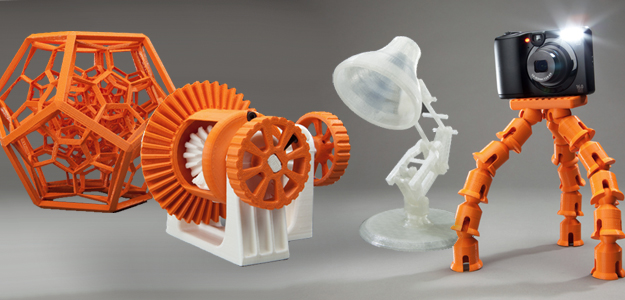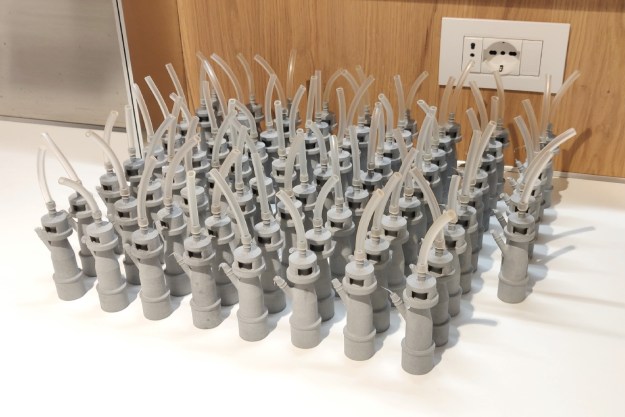 Before the first Apple PC, a “personal computer” was pretty much an expensive calculator, built from a kit, which could answer math problems with switches and lights. The arrival of the Apple II turned its complex predecessors into something anyone could use, and 3D printing might be about to undergo a similar revolution. While we’re still far from the Star Trek dream of being able to print food or replicate complex products like an iPod, 3D printing is on the cusp of moving into your business or living room and being incredibly useful.
Before the first Apple PC, a “personal computer” was pretty much an expensive calculator, built from a kit, which could answer math problems with switches and lights. The arrival of the Apple II turned its complex predecessors into something anyone could use, and 3D printing might be about to undergo a similar revolution. While we’re still far from the Star Trek dream of being able to print food or replicate complex products like an iPod, 3D printing is on the cusp of moving into your business or living room and being incredibly useful.
From drawing board to plastic
If you’ve never watched a 3D printer, they can be a lot of fun – check out this video to get a sense of the state of the art today. These guys scan a crescent wrench, take the image of it, and produce a working duplicate using a 3D printer. I have my doubts whether it would truly be as strong as a steel wrench, but it does appear strong enough for most uses. Imagine: If you wanted to make the wrench larger, smaller, have a bigger handle, you could just adjust it on a computer, then print the unique result to solve your particular problem.
You wouldn’t ever need to buy a tool set, just print the tools you need as you need them. The only problem is, these 3D printers are pretty expensive right now. But they’re getting more affordable, and are already one hell of a long way more useful than the personal computers (or even small business computers) we had in the market before the Apple II shipped.
Rapid prototyping
Most current 3D printers are used for rapid prototyping. Whether used to print functionally accurate models, or to create parts that then can be used to create molds for cast parts used in prototypes, these printers have cut the time to market significantly, for everything from turbochargers to the actual cars they go in.
We’re only at the tip of this inflection point, because people don’t like change much. Engineers used to more traditional methods of prototyping – like clay or wood models – are slowly coming around to the idea of using one of these printers. Once they do, or once the next generation of engineers does, you’ll likely see not only more innovative products, but better ones. After all, with 3D modeling, they can do more prototyping and discover more problems sooner.
So you’ll see the results of 3D printing long because you’ll likely be able to buy one. In fact, many of us are likely seeing the result now but don’t yet realize it.
In the home
The Holy Grail of this market – the one that could do for 3D printing what the iPod did for portable music players – would be an in-home printer. We are likely going to see one of these long before the end of the decade. Reducing the cost of something takes far less time than creating it in the first place, and much of the savings will likely come from making these in higher volume.
From printing art to models, tools for older cars, solid parts, moving parts, house trim, even clothing items like belt buckles, ordinary consumers could find all sorts of uses for a personal 3D printer. Think of something cool, model it on our PC, then make your thoughts solid, and reach into the printer to scoop up your custom-designed gadget. You won’t even need to know how to model for yourself. Want a reproduction of the thing you just saw in the Disney Star Wars movie on your desk? Just download the model file and print it.
A torch looking for a bearer
So, 3D printing is ripe for a revolution, but which company will be the one to pull it off? MakerBot has made a strong push with its affordable Replicator models, but it might not be too late to rule out some older names, either. Oddly enough, HP may have a unique vantage point here. It has already dabbled in commercial 3D printing with the HP-branded Designjet 3D, and currently dominates the traditional consumer printer market with nearly a 40 percent market share. If HP can execute the transition from one to the next, this could be its path to becoming the next Apple.
Whether HP execs see this or not, I think that 3D printing has a good shot at being the next big thing. Do you agree, or do you think some other technology like personal robotics will hit first?
Editors' Recommendations
- Fighting football injuries with 3D-printed, hyper-personalized pads
- The future of sustainability: A look at the next evolution of environmental tech
- Hit takers: The cutting-edge engineering making football helmets safer than ever
- Inside the quest to 3D print a perfectly palatable steak
- The 50-year old Silicon Valley lab that practically invented modern computing


